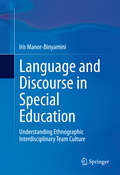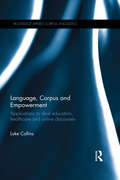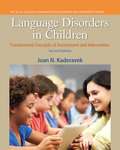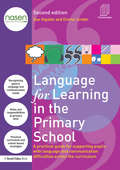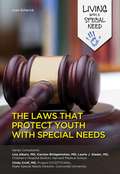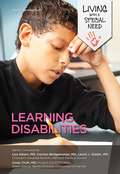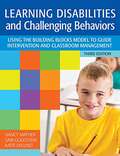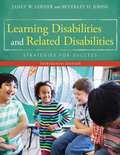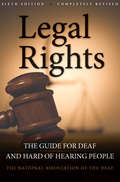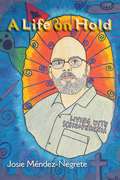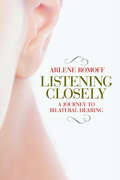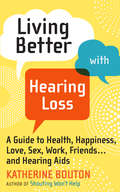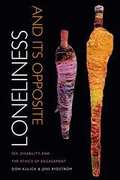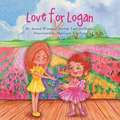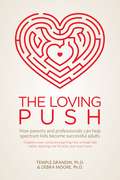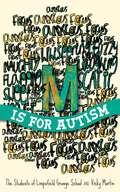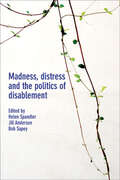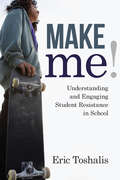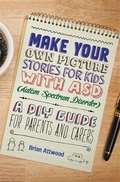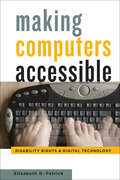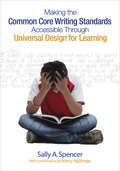- Table View
- List View
Land Use Law and Disability
by Robin Paul MalloyIn Land Use Law and Disability, Robin Paul Malloy argues that our communities need better planning to be safely and easily navigated by people with mobility impairment and to facilitate intergenerational aging in place. To achieve this, communities will need to think of mobility impairment and inclusive design as land use and planning issues, in addition to understanding them as matters of civil and constitutional rights. Although much has been written about the rights of people with disabilities, little has been said about the interplay between disability and land use regulation. This book undertakes to explain mobility impairment, as one type of disability, in terms of planning and zoning. The goal is to advance our understanding of disability in terms of planning and zoning to facilitate cooperative engagement between disability rights advocates and land use professionals. This in turn should lead to improved community planning for accessibility and aging in place.
Language and Discourse in Special Education
by Iris Manor-BinyaminiThis book examines the words and discourse as well as their meaning and impact on the everyday culture of a multidisciplinary team at a school for students with mental disabilities. The book examines the organizational, social, professional, and emotional experiences of team members from such disciplines as child and school psychology, special education, therapy (e. g. , occupational, speech), social work, and pediatric medicine within a special education school. It explores the ways in which team members describe and interpret the day-to-day requirements of working effectively in a special education school, using their own language and discourse from a subjective point of view. In addition, the book analyzes and interprets the influence of language and discourse on the outlook, behavior patterns, and the coping of team members working in the school with the students, among themselves as a team, and with the difficulties and dilemmas that concern them as well the solutions that they themselves introduce for all these issues. This book, with its focus on the unique and complex work environment of the multidisciplinary special education team, is essential reading for researchers, professionals, and graduate students in child and school psychology, therapeutic disciplines (e. g. , occupational, speech), social work, pediatric medicine, and allied mental health and medical fields.
Language, Corpus and Empowerment: Applications to deaf education, healthcare and online discourses (Routledge Applied Corpus Linguistics)
by Luke CollinsLanguage, Corpus and Empowerment applies a novel corpus-driven approach to the exploration of the concept of empowerment in healthcare. The book proposes an innovative corpus-based methodology for finding evidence of empowerment in language use, using data from a video intervention delivered to families of deaf children, as well as assessing the effects of the intervention on the family. Language, Corpus and Empowerment provides a working definition of empowerment which incorporates concepts from linguistics and learning theory; uses corpus analysis to provide evidence of how video interventions can transform people’s perspectives; examines this new methodology as a potential tool for analysing conversational data longitudinally and at a case-by-case level; demonstrates how a corpus-based methodological approach can be applied in conjunction with other language-based approaches, such as discourse analysis and conversation analysis, to explore the ways in which complex social processes occur in interaction; makes a valuable development in the assessment of the impact of healthcare interventions and the language of empowerment. Insightful and ground-breaking, Language, Corpus and Empowerment is essential reading for anyone undertaking research within corpus linguistics.
Language Disorders in Children: Fundamental Concepts of Assessment and Intervention
by Joan N. KaderavekThis text is more than an introductory look at language disorders. It goes beyond basic concepts and basic definitions to teach students how to analyze, synthesize, evaluate, and link the information they are learning. It offers readers opportunities for higher-order learning, while preparing students to become careful evaluators of information, as well as adept problem solvers. Organized by disorder groups and theme, Language Disorders in Children, 2/e helps students easily make connections between theoretical information and clinical practice through a number of thoughtful features such as case histories, clinical decision trees, and hot topic discussions. It's an approach that meets the needs of today's students to learn lifetime critical thinking skills, to see relationships between isolated ideas and facts, and to think like a speech-language pathologist.
Language for Learning in the Primary School: A practical guide for supporting pupils with language and communication difficulties across the curriculum (nasen spotlight)
by Sue Hayden Emma JordanLanguage for Learning in the Primary School is the long awaited second edition of Language for Learning, first published in 2004 and winner of the NASEN/TES Book Award for Teaching and Learning in 2005. This handbook has become an indispensable resource, packed full of practical suggestions on how to support 5-11 year old children with speech, language and communication difficulties. Colour coded throughout for easy referencing, this unique book supports inclusive practice by helping teachers to: Identify children with speech, language and communication needs (SLCN) Understand speech, language and communication skills Consider roles and responsibilities at primary school Plan a differentiated and adapted curriculum Consider the language demands across subjects Adopt a whole school approach Make use of a wide range of positive strategies Empower children to access the curriculum Language for Learning in the Primary School comes complete with a wealth of photocopiable resources, giving teachers and teaching assistants the confidence to help children with SLCN more effectively in mainstream settings. It will also be an extremely useful resource for speech and language therapists, specialist teachers and educational psychologists.
The Laws That Protect Youth with Special Needs
by Joan EsherickMillions of people with special needs experience problems like prejudice, limited opportunities, and difficulties accessing the facilities that should be freely available. Luckily, there are laws in place today to protect their rights. Maria, a beautiful young girl with dreams of becoming a model, isn't allowed to participate in a local modeling workshop. Why? Because she uses a wheelchair. Another student with a disability is threatened by the loss of medical funding from the government, just because he's turning twenty-one; if he loses the government's help, he'll have to stop going to school and start living in a nursing home. What can he do to fight the situation? Meanwhile, nineteen-year-old Manuel is rejected from a job because of his history of seizures, even though he takes medication and hasn't had a seizure in more than five years. Is there something Manuel can do to get the job? As you read these young adults' stories, you'll learn about the laws that protect their rights. You'll discover the history behind these laws, and you'll find out exactly which rights are protected.
Learning Disabilities
by Shirley BrinkerhoffLearning disabilities are extremely common. Teachers and parents often make the mistake of thinking children with these disabilities aren't trying hard enough or simply aren't as intelligent as other students--but in reality, young people with learning disabilities simply need special attention and a different approach to learning. Read about Charlie Begay, who thought he liked school, at least until he got to first grade. Now, no matter how hard he tries, he just can't make the words on the pages make sense--and his teacher doesn't seem to understand how hard he's trying. As you read Charlie's story, you'll discover some of the issues young people with learning disabilities face in today's educational system--and you'll learn how the educational system can help students overcome their disabilities.
Learning Disabilities And Challenging Behaviors: A Guide To Intervention And Classroom Management, Third Edition
by Nancy Mather Ph. D. Sam Goldstein Katie EklundWhy do students in Grades K–12 struggle with social and academic skills, and how can teachers help them develop the competence and confidence they need to succeed? Get practical answers in the new edition of this bestselling book, a staple of teacher training since 2001. It's structured like the popular previous editions: a detailed questionnaire pinpoints each student's individual strengths and needs, and an updated version of the highly effective Building Blocks model helps educators target 12 school success factors with proven strategies and guidelines they can use right away. Reliable, up-to-date research makes this a perfect preservice textbook, and the classroom-ready strategies are a lifeline for in-service teachers as they work toward better outcomes for struggling students.
Learning Disabilities and Related Disabilities: Strategies for Success (Thirteenth Edition)
by Janet W. Lerner Beverley JohnsThe text that set the standard for students working toward certification in special education has been revised and updated to meet the needs of a new generation of teachers and students. Written for undergraduate and graduate students who are majoring in general education or special education, the book features a cross-categorical emphasis that makes it suitable for a broad number of courses-including those aimed at teaching students with related disabilities and those teaching students on the Autism Spectrum. The authors describe the characteristics of learning disabilities as well as other disabilities, and offer practical teaching strategies for general education teachers, special education teachers, school psychologists, administrators, and related professionals. Pre-service and in-service classroom teachers, who are increasingly responsible for teaching students with special needs within general education or inclusive classrooms, will find LEARNING DISABILITIES AND RELATED DISABILITIES: STRATEGIES FOR SUCCESS, 13th Edition, especially helpful.
Legal Rights, 6th Ed.: The Guide for Deaf and Hard of Hearing People
by National Association of the DeafThe standard handbook on law affecting deaf and hard of hearing people has been completely rewritten and updated. The sixth edition of Legal Rights: The Guide for Deaf and Hard of Hearing People meticulously describes those statutes that prohibit discrimination against deaf and hard of hearing people, and any others with physical challenges. Written in easy-to-understand language, the new edition describes the core legislation and laws and their critical importance since their inception: The Rehabilitation Act of 1973, the Individuals with Disabilities Education Act (IDEA), and the Americans with Disabilities Act (ADA). The new Legal Rights also explains the significant amendments to these laws, including the ADA Amendments Act (ADAAA) and new regulations to its Title II concerning public entities and Title III pertaining to public accommodations and commercial facilities. The reauthorization of IDEA expanded the No Child Left Behind Act requirement for highly qualified teachers to all students with disabilities. This new edition also tracks the trend of passing a Deaf and Hard of Hearing Children's Bill of Rights in a growing number of state legislatures. This completely new resource also delineates new legislation such as the Twenty-First Century Communications Video and Accessibility Act, which ensures access to the newest communications technology for deaf and hard of hearing people. Legal Rights also includes information on the use of interpreters in the legal system, securing its position as the most comprehensive reference of legal information for deaf and hard of hearing people now available.
Leveling the Playing Field: Improving Technology Access and Design for People with Intellectual Disabilities
by Presidents Committee for People w/Intellectual DisabilitiesThe President's Committee for People with Intellectual Disabilities is honored to advise the President and the Secretary of Health and Human Services about the role of technology in improving the quality of life for people with ID and ensuring their full citizenship rights. A new generation of technologies continues to redefine, at an accelerated pace, how we all live, grow, and excel. The same should be true for people with ID. Access to technology is critical for people with ID to fully engage in the everyday life of our society.
A Life on Hold: Living with Schizophrenia
by Josie Méndez-NegreteFor more than twenty years Josie Méndez-Negrete has endured the emotional journey of watching her son Tito struggle with schizophrenia. Her powerful account is the first memoir by a Mexican American author to share the devastation and hope a family experiences in dealing with this mental illness. Méndez-Negrete depicts the evolution of the disease from her perspective as a parent and by relating Tito's own narrative, illuminating the inadequacies of the US mental health system and the added burdens of addiction and blame. Through the author, Tito paints a vivid picture of his lived experiences and everyday traumas to show how his life and the lives of his loved ones have been impacted by mental illness.
Listening Closely: A Journey to Bilateral Hearing
by Arlene RomoffImagine what it would be like not to hear a sound--no music, no friendly voices, no children's laughter. Arlene Romoff doesn't have to imagine how it would feel: she lived it. Although she was born with normal hearing, in her late teens it began to slip away, as if someone were lowering the volume of the world around her. Over the next twenty-five years, Arlene began a long, slow descent into deafness so profound that no hearing aid or assistive device could help. The experience was devastating.But then Arlene opted for what she considers a miracle: She got a cochlear implant. Using electrodes threaded into the cochlea, an internal computer chip, and an external computer processor, cochlear implants bypass the damaged portion of the cochlea and stimulate the auditory nerve directly, allowing sound to reach the brain. Amazingly, she could hear again.Arlene's journey, however, isn't just about the magic of technology. What she endured reveals as much about the strength of the human spirit, about the wonders of chance and fate, and about making the most of what life dishes out. For Arlene, events seemed to unfold almost as if they were a part of some elaborate plan: just when she went deaf, her insurance company began paying for the implants. And ten years later, when her old cochlear implant finally failed she received new state-of-the-art technology and underwent yet another metamorphosis--one that helped her continue to counsel others in a similar situation.LISTENING CLOSELY will give you a chance to walk in Arlene Romoff's shoes, to understand the pain of her loss and the joy of once again being able to hear the music of the world. Those suffering from hearing loss--or who have loved one who is--will find Arlene's very special journey both inspirational and informative.
Living Better with Hearing Loss: A Guide to Health, Happiness, Love, Sex, Work, Friends . . . and Hearing Aids
by Katherine BoutonMore than 48 million Americans suffer from hearing loss, and audiologists agree this is a national epidemic. LIVING BETTER WITH HEARING LOSS is a practical guide to daily life with hearing loss, covering topics from hearing tests and buying (and paying for) hearing aids, to deciding whether to get a cochlear implant, to navigating airports, job interviews, and first dates when you suffer from hearing loss. Useful and readable for the newly hearing-impaired, those who have been struggling for years, and their families. Author Katherine Bouton has also written Shouting Won't Help, a memoir of her adult-onset hearing loss.
Loneliness and Its Opposite: Sex, Disability, and the Ethics of Engagement
by Jens Rydström Don KulickFew people these days would oppose making the public realm of space, social services and jobs accessible to women and men with disabilities. But what about access to the private realm of desire and sexuality? How can one also facilitate access to that, in ways that respect the integrity of disabled adults, and also of those people who work with and care for them?Loneliness and Its Opposite documents how two countries generally imagined to be progressive engage with these questions in very different ways. Denmark and Sweden are both liberal welfare states, but they diverge dramatically when it comes to sexuality and disability. In Denmark, the erotic lives of people with disabilities are acknowledged and facilitated. In Sweden, they are denied and blocked. Why do these differences exist, and how do both facilitation and hindrance play out in practice?Loneliness and Its Opposite charts complex boundaries between private and public, love and sex, work and intimacy, and affection and abuse. It shows how providing disabled adults with access to sexual lives is not just crucial for a life with dignity. It is an issue of fundamental social justice with far reaching consequences for everyone.
Love For Logan
by Lori Demonia Monique TurchanLove for Logan is an inspirational story based on actual events. A young girl learns to better understand why day to day life can be challenging for her older sister. While sharing a special night, the story embraces how one girl's love for her sister empowers her to overcome one of life's obstacles.
The Loving Push: How Parents and Professionals Can Help Spectrum Kids Become Successful Adults
by Temple Grandin Debra MooreThe purpose of this book is to help parents let go and give careful, loving pushes to get their child to try new things. Temple Grandin, Debra Moore spell out which steps you can take to restore your child’s hope and motivation--and what you must avoid.
M is for Autism
by Vicky Martin The Students of Limpsfield Grange School Robert PritchettM. That's what I'd like you to call me please. I'll tell you why later. Welcome to M's world. It's tipsy-turvy, sweet and sour, and the beast of anxiety lurks outside classrooms ready to pounce. M just wants to be like other teenagers her age who always know what to say and what to do. So why does it feel like she lives on a different plane of existence to everyone else? Written by the students of Limpsfield Grange, a school for girls with Autism Spectrum Disorder with communication and interaction difficulties, M is for Autism draws on real life experiences to create a heartfelt and humorous novel that captures the highs and lows of being different in a world of normal.
Madness, Distress and the Politics of Disablement
by Helen Spandler, Jill Anderson and Bob SapeyThis book explores the challenges of applying disability theory and policy, including the social model of disability, to madness and distress. It brings together leading scholars and activists from Europe, North America, Australia and India, to explore the relationship between madness, distress and disability. Whether mental health problems should be viewed as disabilities is a pressing concern, especially since the inclusion of psychosocial disability in the UN Convention on the Rights of Persons with Disabilities. This book will appeal to policy makers, practitioners, activists and academics.
Magnets and Ladders: Spring/Summer 2015
by Active Voices of Writers with DisabilitiesMagnets and Ladders is an online literary magazine that features poems, short stories, memoirs, and personal essays by writers with disabilities. The magazine is divided into sections that reflect the content of selections and voice of the authors. Topics include: life events, memoir, science fiction, nature, current issues, music, art, travel, and the craft of writing. Stories and poems about holidays and the season are also featured. Although the authors published in Magnets and Ladders have disabilities, most of their writing is not about disability. These authors have had a multitude of enriching experiences and they are proud to share them with you.
Magnets and Ladders: Fall/Winter 2015-2016
by Active Voices of Writers with DisabilitiesMagnets and Ladders is an online literary magazine that features poems, short stories, memoirs, and personal essays by writers with disabilities. The magazine is divided into sections that reflect the content of selections and voice of the authors. Topics include: life events, memoir, science fiction, nature, current issues, music, art, travel, and the craft of writing. Stories and poems about holidays and the season are also featured. Although the authors published in Magnets and Ladders have disabilities, most of their writing is not about disability. These authors have had a multitude of enriching experiences and they are proud to share them with you.
Make Me!: Understanding and Engaging Student Resistance in School (Youth Development and Education Series)
by Eric ToshalisIn this groundbreaking book, Eric Toshalis explores student resistance through a variety of perspectives, arguing that oppositional behaviors can be not only instructive but productive. All too often treated as a matter of compliance, student resistance can also be understood as a form of engagement, as young people confront and negotiate new identities in the classroom environment. The focus of teachers&’ efforts, Toshalis says, should not be about &“managing&” adolescents but about learning how to read their behavior and respond to it in developmentally productive, culturally responsive, and democratically enriching ways. Noting that the research literature is scattered across fields, Toshalis draws on four domains of inquiry: theoretical, psychological, political, and pedagogical. The result is a resource that can help teachers address this pervasive classroom challenge in ways that enhance student agency, motivation, engagement, and academic achievement. The coauthor ofUnderstanding Youth: Adolescent Development for Educators (Harvard Education Press, 2006), Toshalis blends accessible explanations of theory and research with vignettes of interactions among educators and students. In Make Me!, Toshalis helps teachers perceive possibility, rather than pathology, in student resistance.
Make Your Own Picture Stories for Kids with ASD (Autism Spectrum Disorder): A DIY Guide for Parents and Carers
by Brian AttwoodPicture stories can play a vital role in helping parents negotiate challenging scenarios with kids with ASD. Yet no matter how many books and flashcards you have, they can't cover every eventuality. So, suppose you could draw the stories yourself... Brian Attwood took up pen and paper when his son John's meltdowns became harder to deal with. The effect was immediate and time and time again picture stories have bailed the family out of trouble and saved John from unhappiness and confusion. In this book, Brian describes step-by-step how to create simple yet effective picture stories using basic drawings and short lines of text, and provides examples based on real-life situations for you to adapt for your child. This book will give parents and carers the tools and confidence they need to create individualised picture stories to help their child with ASD cope with social situations, difficult emotions, transitions and other challenging situations.
Making Computers Accessible: Disability Rights and Digital Technology
by Elizabeth R. PetrickThe revolution in accessible computer technology was fueled by disability activism, the interactive nature of personal computers, and changing public policy.In 1974, not long after developing the first universal optical character recognition technology, Raymond Kurzweil struck up a conversation with a blind man on a flight. Kurzweil explained that he was searching for a use for his new software. The blind man expressed interest: One of the frustrating obstacles that blind people grappled with, he said, was that no computer program could translate text into speech. Inspired by this chance meeting, Kurzweil decided that he must put his new innovation to work to "overcome this principal handicap of blindness." By 1976, he had built a working prototype, which he dubbed the Kurzweil Reading Machine.This type of innovation demonstrated the possibilities of computers to dramatically improve the lives of people living with disabilities. In Making Computers Accessible, Elizabeth R. Petrick tells the compelling story of how computer engineers and corporations gradually became aware of the need to make computers accessible for all people. Motivated by user feedback and prompted by legislation such as the Americans with Disabilities Act, which offered the promise of equal rights via technological accommodation, companies developed sophisticated computerized devices and software to bridge the accessibility gap. People with disabilities, Petrick argues, are paradigmatic computer users, demonstrating the personal computer’s potential to augment human abilities and provide for new forms of social, professional, and political participation. Bridging the history of technology, science and technology studies, and disability studies, this book traces the psychological, cultural, and economic evolution of a consumer culture aimed at individuals with disabilities, who increasingly rely on personal computers to make their lives richer and more interconnected.
Making the Common Core Writing Standards Accessible Through Universal Design for Learning
by Sally A. SpencerUnlock hidden writing skills in all learners through UDL! The Common Core State Standards (CCSS) for writing are promising but are challenging to implement, especially for struggling students. Sally A. Spencer demonstrates the promise of Universal Design for Learning (UDL) as a framework for making the CCSS writing and language standards accessible to all kids. Educators who utilize these strategies will know: How to leverage the strengths of students to optimize writing instruction and overcome their weaknesses The ways UDL can minimize the roadblocks in CCSS implementation How to - and how not to - use technology to teach writing and language conventions

